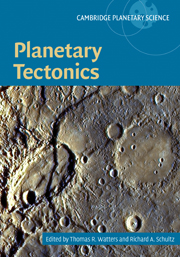Book contents
- Frontmatter
- Contents
- List of contributors
- Preface
- 1 Planetary tectonics: introduction
- 2 The tectonics of Mercury
- 3 Venus tectonics
- 4 Lunar tectonics
- 5 Mars tectonics
- 6 Tectonics of small bodies
- 7 Tectonics of the outer planet satellites
- 8 Planetary structural mapping
- 9 Strength and deformation of planetary lithospheres
- 10 Fault populations
- Index
- Plates
- References
4 - Lunar tectonics
Published online by Cambridge University Press: 30 March 2010
- Frontmatter
- Contents
- List of contributors
- Preface
- 1 Planetary tectonics: introduction
- 2 The tectonics of Mercury
- 3 Venus tectonics
- 4 Lunar tectonics
- 5 Mars tectonics
- 6 Tectonics of small bodies
- 7 Tectonics of the outer planet satellites
- 8 Planetary structural mapping
- 9 Strength and deformation of planetary lithospheres
- 10 Fault populations
- Index
- Plates
- References
Summary
Summary
Tectonic landforms on the Moon predominantly occur on the nearside, associated directly with the lunar maria. Basin-localized lunar tectonics is expressed by two landforms: wrinkle ridges, and linear and arcuate rilles or troughs. Wrinkle ridges are complex morphologic landforms found in mare basalts, interpreted to be contractional tectonic landforms formed by thrust faulting and folding. Linear and arcuate rilles are long, narrow troughs, interpreted to be graben formed by extension, deforming both mare basalts at basin margins and the highlands adjacent to the basins. In contrast to basin-localized tectonics, landforms of the nearside are the more broadly distributed lobate scarps. Lobate scarps on the Moon are relatively small-scale asymmetric landforms that are often segmented with lobate margins. These landforms are the surface expression of thrust faults and are the dominant tectonic feature on the lunar farside. Crater density ages indicate that crustal extension associated with lunar maria ceased at ~3.6 Ga. Crustal shortening in the maria, however, continued to as recently as ~1.2 Ga. The cessation of extension may have resulted from the superposition of compressional stresses from global contraction on flexural extensional stress due to loading from the mare basalts. The lobate scarps formed less than 1 Ga and appear to be among the youngest endogenic features on the Moon. The presence of young lobate scarp thrust faults supports late-stage compression of the lunar crust.
Information
- Type
- Chapter
- Information
- Planetary Tectonics , pp. 121 - 182Publisher: Cambridge University PressPrint publication year: 2009
References
Accessibility standard: Unknown
Why this information is here
This section outlines the accessibility features of this content - including support for screen readers, full keyboard navigation and high-contrast display options. This may not be relevant for you.Accessibility Information
- 14
- Cited by
